Variance Analysis in Management Accounting
VerifiedAdded on 2023/01/09
|10
|3238
|89
AI Summary
This report provides an insight into variance analysis in management accounting, specifically focusing on sales price variance, sales volume contribution variance, material price planning variance, and material price operational variance. It discusses the benefits and limitations of using variances in analyzing manager performance. The report also includes computations and explanations for each variance.
Contribute Materials
Your contribution can guide someone’s learning journey. Share your
documents today.
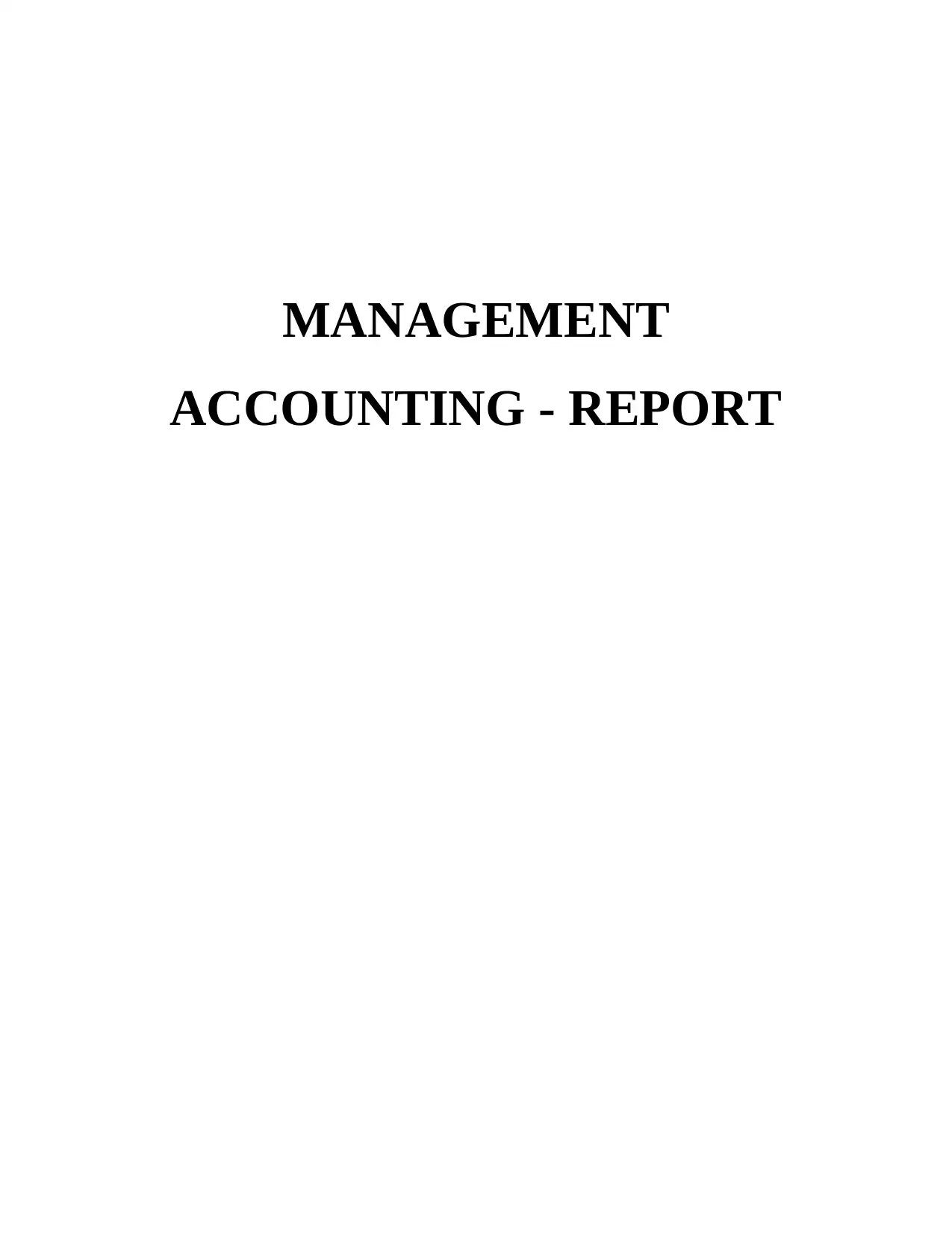
MANAGEMENT
ACCOUNTING - REPORT
ACCOUNTING - REPORT
Secure Best Marks with AI Grader
Need help grading? Try our AI Grader for instant feedback on your assignments.
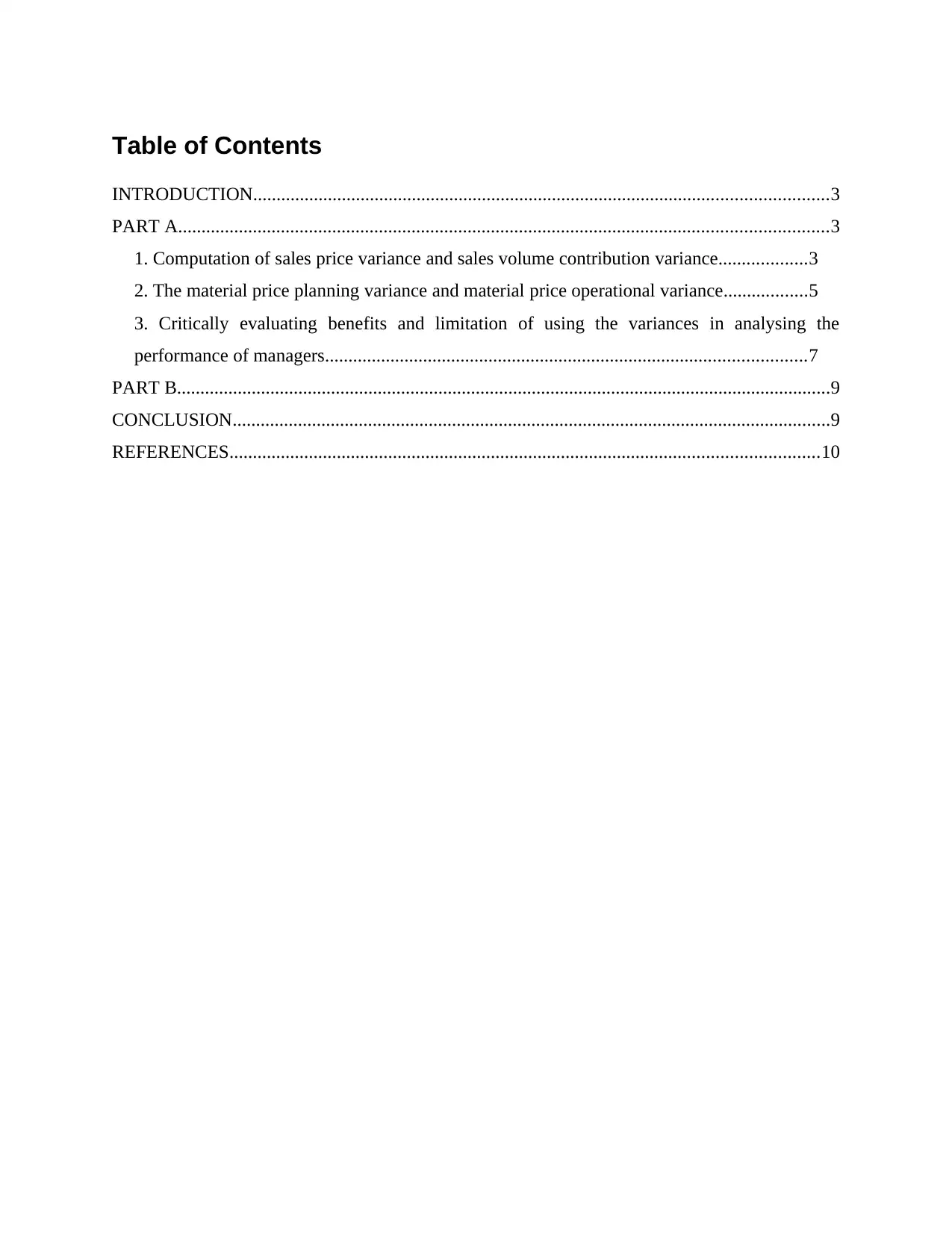
Table of Contents
INTRODUCTION...........................................................................................................................3
PART A...........................................................................................................................................3
1. Computation of sales price variance and sales volume contribution variance...................3
2. The material price planning variance and material price operational variance..................5
3. Critically evaluating benefits and limitation of using the variances in analysing the
performance of managers.......................................................................................................7
PART B............................................................................................................................................9
CONCLUSION................................................................................................................................9
REFERENCES..............................................................................................................................10
INTRODUCTION...........................................................................................................................3
PART A...........................................................................................................................................3
1. Computation of sales price variance and sales volume contribution variance...................3
2. The material price planning variance and material price operational variance..................5
3. Critically evaluating benefits and limitation of using the variances in analysing the
performance of managers.......................................................................................................7
PART B............................................................................................................................................9
CONCLUSION................................................................................................................................9
REFERENCES..............................................................................................................................10
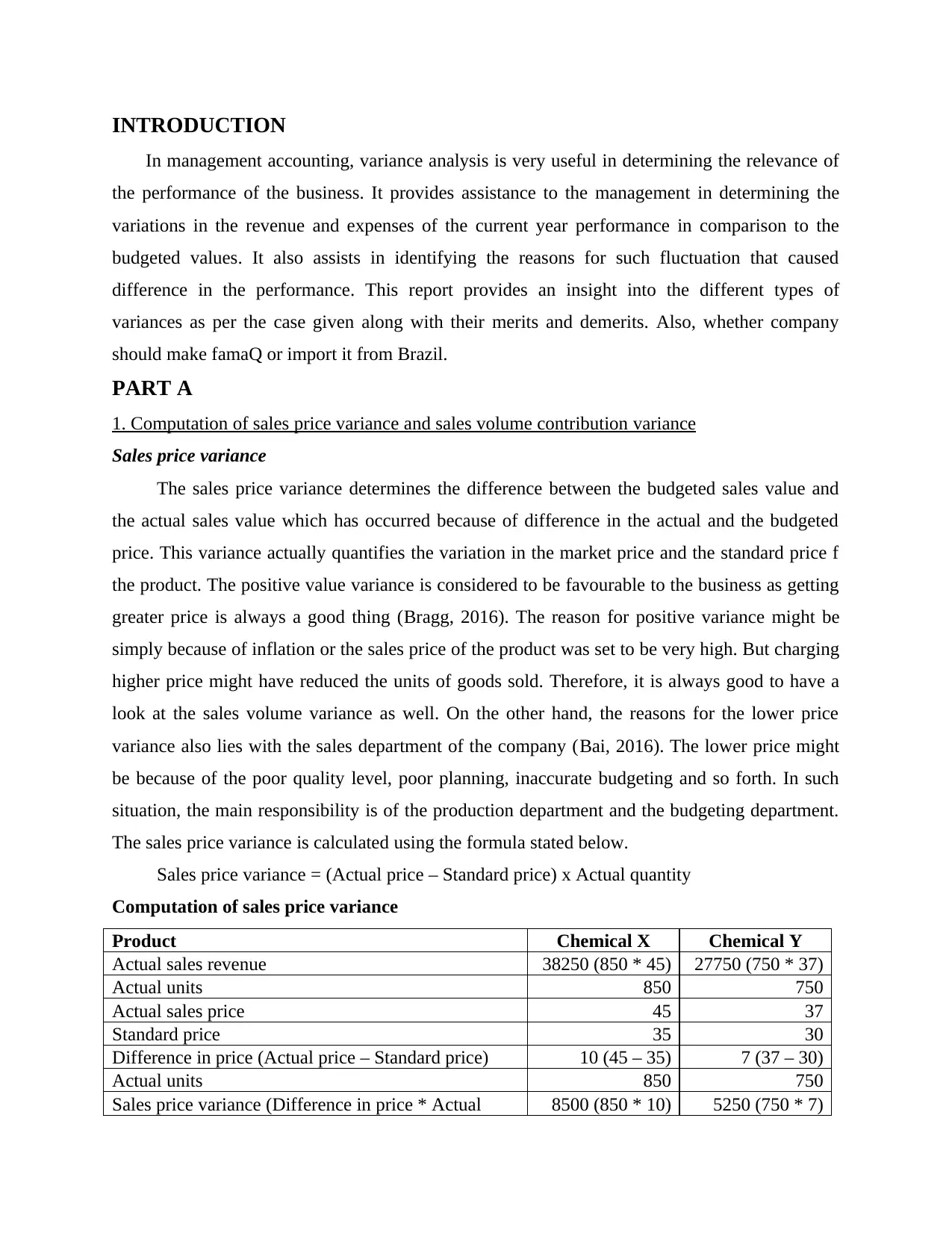
INTRODUCTION
In management accounting, variance analysis is very useful in determining the relevance of
the performance of the business. It provides assistance to the management in determining the
variations in the revenue and expenses of the current year performance in comparison to the
budgeted values. It also assists in identifying the reasons for such fluctuation that caused
difference in the performance. This report provides an insight into the different types of
variances as per the case given along with their merits and demerits. Also, whether company
should make famaQ or import it from Brazil.
PART A
1. Computation of sales price variance and sales volume contribution variance
Sales price variance
The sales price variance determines the difference between the budgeted sales value and
the actual sales value which has occurred because of difference in the actual and the budgeted
price. This variance actually quantifies the variation in the market price and the standard price f
the product. The positive value variance is considered to be favourable to the business as getting
greater price is always a good thing (Bragg, 2016). The reason for positive variance might be
simply because of inflation or the sales price of the product was set to be very high. But charging
higher price might have reduced the units of goods sold. Therefore, it is always good to have a
look at the sales volume variance as well. On the other hand, the reasons for the lower price
variance also lies with the sales department of the company (Bai, 2016). The lower price might
be because of the poor quality level, poor planning, inaccurate budgeting and so forth. In such
situation, the main responsibility is of the production department and the budgeting department.
The sales price variance is calculated using the formula stated below.
Sales price variance = (Actual price – Standard price) x Actual quantity
Computation of sales price variance
Product Chemical X Chemical Y
Actual sales revenue 38250 (850 * 45) 27750 (750 * 37)
Actual units 850 750
Actual sales price 45 37
Standard price 35 30
Difference in price (Actual price – Standard price) 10 (45 – 35) 7 (37 – 30)
Actual units 850 750
Sales price variance (Difference in price * Actual 8500 (850 * 10) 5250 (750 * 7)
In management accounting, variance analysis is very useful in determining the relevance of
the performance of the business. It provides assistance to the management in determining the
variations in the revenue and expenses of the current year performance in comparison to the
budgeted values. It also assists in identifying the reasons for such fluctuation that caused
difference in the performance. This report provides an insight into the different types of
variances as per the case given along with their merits and demerits. Also, whether company
should make famaQ or import it from Brazil.
PART A
1. Computation of sales price variance and sales volume contribution variance
Sales price variance
The sales price variance determines the difference between the budgeted sales value and
the actual sales value which has occurred because of difference in the actual and the budgeted
price. This variance actually quantifies the variation in the market price and the standard price f
the product. The positive value variance is considered to be favourable to the business as getting
greater price is always a good thing (Bragg, 2016). The reason for positive variance might be
simply because of inflation or the sales price of the product was set to be very high. But charging
higher price might have reduced the units of goods sold. Therefore, it is always good to have a
look at the sales volume variance as well. On the other hand, the reasons for the lower price
variance also lies with the sales department of the company (Bai, 2016). The lower price might
be because of the poor quality level, poor planning, inaccurate budgeting and so forth. In such
situation, the main responsibility is of the production department and the budgeting department.
The sales price variance is calculated using the formula stated below.
Sales price variance = (Actual price – Standard price) x Actual quantity
Computation of sales price variance
Product Chemical X Chemical Y
Actual sales revenue 38250 (850 * 45) 27750 (750 * 37)
Actual units 850 750
Actual sales price 45 37
Standard price 35 30
Difference in price (Actual price – Standard price) 10 (45 – 35) 7 (37 – 30)
Actual units 850 750
Sales price variance (Difference in price * Actual 8500 (850 * 10) 5250 (750 * 7)
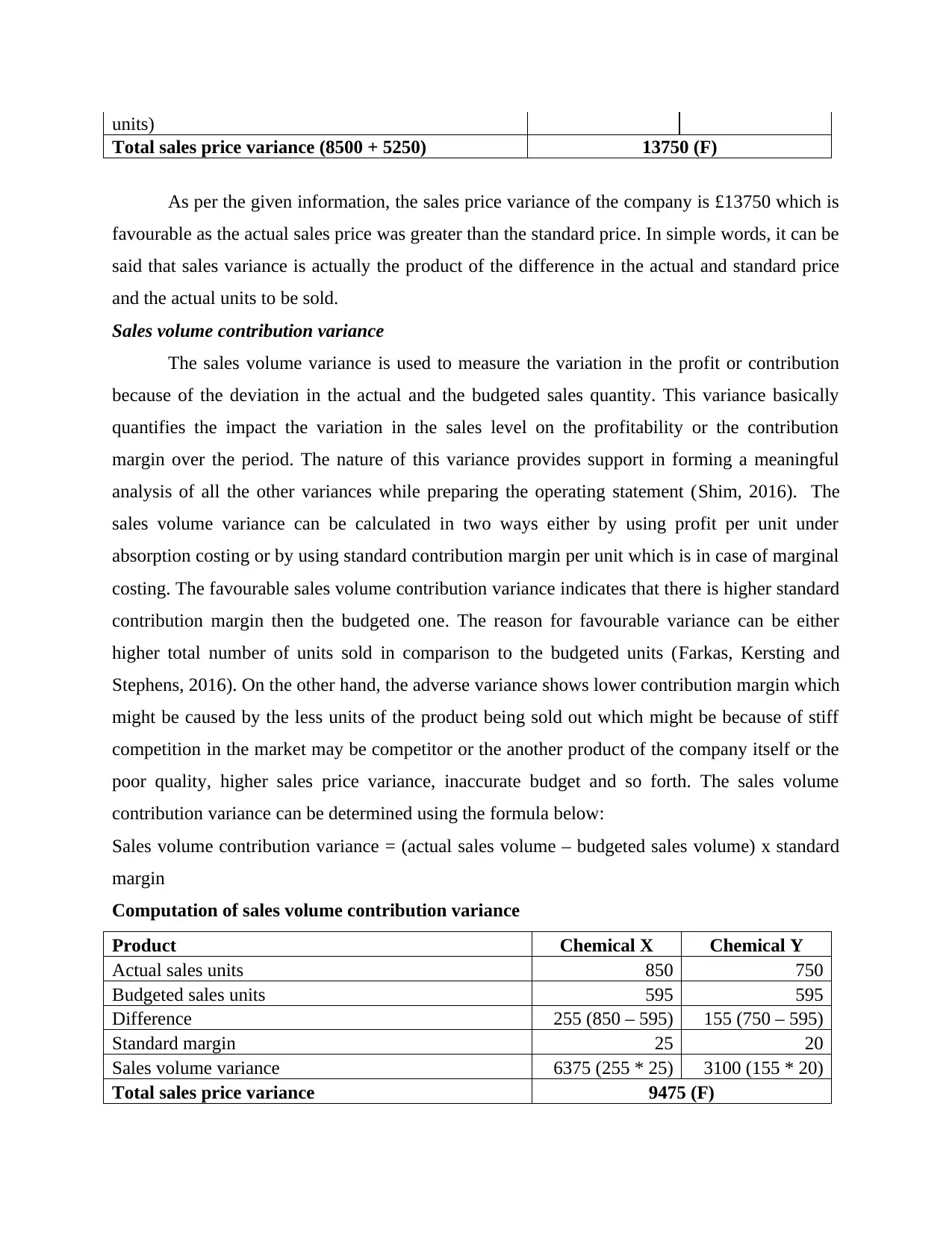
units)
Total sales price variance (8500 + 5250) 13750 (F)
As per the given information, the sales price variance of the company is £13750 which is
favourable as the actual sales price was greater than the standard price. In simple words, it can be
said that sales variance is actually the product of the difference in the actual and standard price
and the actual units to be sold.
Sales volume contribution variance
The sales volume variance is used to measure the variation in the profit or contribution
because of the deviation in the actual and the budgeted sales quantity. This variance basically
quantifies the impact the variation in the sales level on the profitability or the contribution
margin over the period. The nature of this variance provides support in forming a meaningful
analysis of all the other variances while preparing the operating statement (Shim, 2016). The
sales volume variance can be calculated in two ways either by using profit per unit under
absorption costing or by using standard contribution margin per unit which is in case of marginal
costing. The favourable sales volume contribution variance indicates that there is higher standard
contribution margin then the budgeted one. The reason for favourable variance can be either
higher total number of units sold in comparison to the budgeted units (Farkas, Kersting and
Stephens, 2016). On the other hand, the adverse variance shows lower contribution margin which
might be caused by the less units of the product being sold out which might be because of stiff
competition in the market may be competitor or the another product of the company itself or the
poor quality, higher sales price variance, inaccurate budget and so forth. The sales volume
contribution variance can be determined using the formula below:
Sales volume contribution variance = (actual sales volume – budgeted sales volume) x standard
margin
Computation of sales volume contribution variance
Product Chemical X Chemical Y
Actual sales units 850 750
Budgeted sales units 595 595
Difference 255 (850 – 595) 155 (750 – 595)
Standard margin 25 20
Sales volume variance 6375 (255 * 25) 3100 (155 * 20)
Total sales price variance 9475 (F)
Total sales price variance (8500 + 5250) 13750 (F)
As per the given information, the sales price variance of the company is £13750 which is
favourable as the actual sales price was greater than the standard price. In simple words, it can be
said that sales variance is actually the product of the difference in the actual and standard price
and the actual units to be sold.
Sales volume contribution variance
The sales volume variance is used to measure the variation in the profit or contribution
because of the deviation in the actual and the budgeted sales quantity. This variance basically
quantifies the impact the variation in the sales level on the profitability or the contribution
margin over the period. The nature of this variance provides support in forming a meaningful
analysis of all the other variances while preparing the operating statement (Shim, 2016). The
sales volume variance can be calculated in two ways either by using profit per unit under
absorption costing or by using standard contribution margin per unit which is in case of marginal
costing. The favourable sales volume contribution variance indicates that there is higher standard
contribution margin then the budgeted one. The reason for favourable variance can be either
higher total number of units sold in comparison to the budgeted units (Farkas, Kersting and
Stephens, 2016). On the other hand, the adverse variance shows lower contribution margin which
might be caused by the less units of the product being sold out which might be because of stiff
competition in the market may be competitor or the another product of the company itself or the
poor quality, higher sales price variance, inaccurate budget and so forth. The sales volume
contribution variance can be determined using the formula below:
Sales volume contribution variance = (actual sales volume – budgeted sales volume) x standard
margin
Computation of sales volume contribution variance
Product Chemical X Chemical Y
Actual sales units 850 750
Budgeted sales units 595 595
Difference 255 (850 – 595) 155 (750 – 595)
Standard margin 25 20
Sales volume variance 6375 (255 * 25) 3100 (155 * 20)
Total sales price variance 9475 (F)
Secure Best Marks with AI Grader
Need help grading? Try our AI Grader for instant feedback on your assignments.
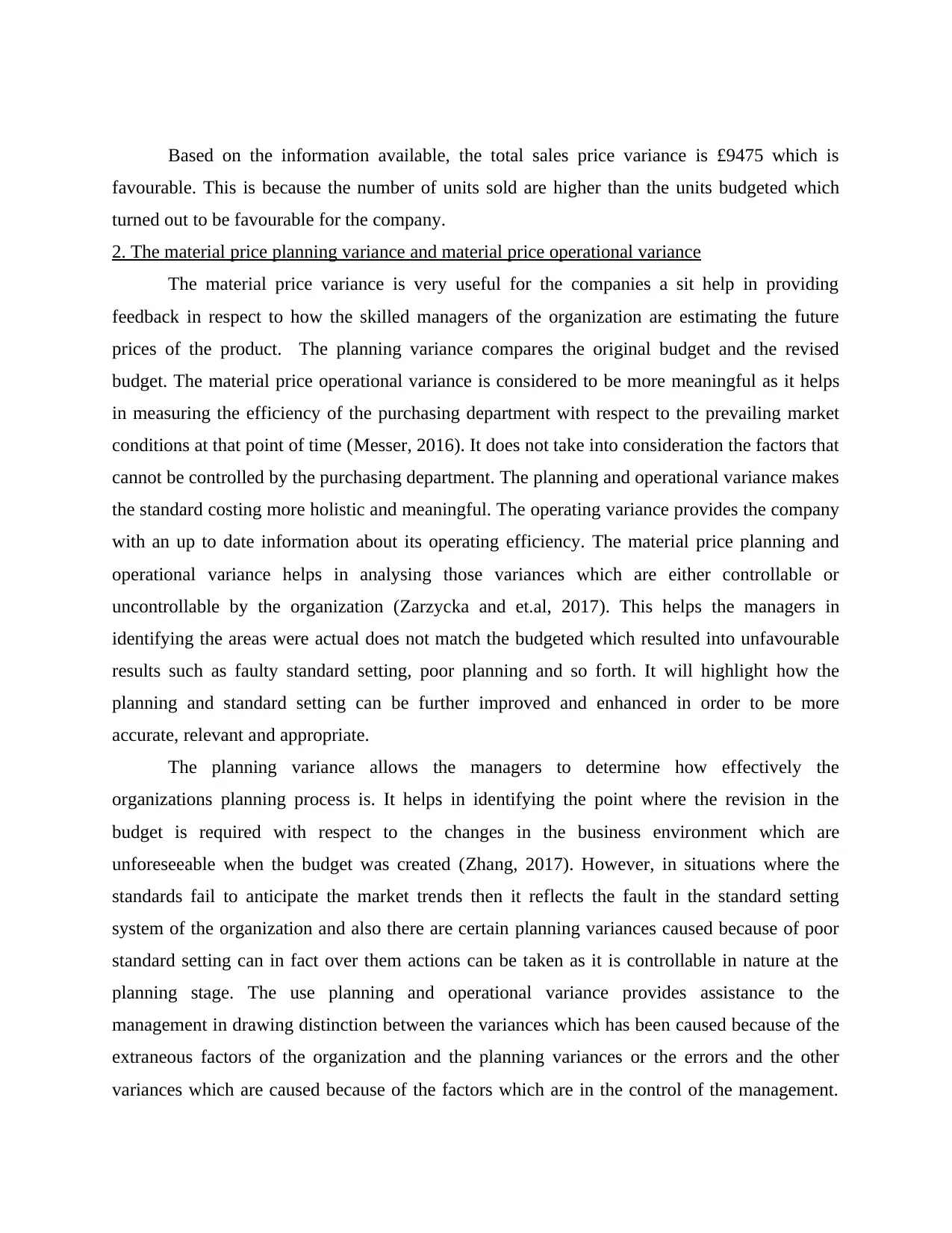
Based on the information available, the total sales price variance is £9475 which is
favourable. This is because the number of units sold are higher than the units budgeted which
turned out to be favourable for the company.
2. The material price planning variance and material price operational variance
The material price variance is very useful for the companies a sit help in providing
feedback in respect to how the skilled managers of the organization are estimating the future
prices of the product. The planning variance compares the original budget and the revised
budget. The material price operational variance is considered to be more meaningful as it helps
in measuring the efficiency of the purchasing department with respect to the prevailing market
conditions at that point of time (Messer, 2016). It does not take into consideration the factors that
cannot be controlled by the purchasing department. The planning and operational variance makes
the standard costing more holistic and meaningful. The operating variance provides the company
with an up to date information about its operating efficiency. The material price planning and
operational variance helps in analysing those variances which are either controllable or
uncontrollable by the organization (Zarzycka and et.al, 2017). This helps the managers in
identifying the areas were actual does not match the budgeted which resulted into unfavourable
results such as faulty standard setting, poor planning and so forth. It will highlight how the
planning and standard setting can be further improved and enhanced in order to be more
accurate, relevant and appropriate.
The planning variance allows the managers to determine how effectively the
organizations planning process is. It helps in identifying the point where the revision in the
budget is required with respect to the changes in the business environment which are
unforeseeable when the budget was created (Zhang, 2017). However, in situations where the
standards fail to anticipate the market trends then it reflects the fault in the standard setting
system of the organization and also there are certain planning variances caused because of poor
standard setting can in fact over them actions can be taken as it is controllable in nature at the
planning stage. The use planning and operational variance provides assistance to the
management in drawing distinction between the variances which has been caused because of the
extraneous factors of the organization and the planning variances or the errors and the other
variances which are caused because of the factors which are in the control of the management.
favourable. This is because the number of units sold are higher than the units budgeted which
turned out to be favourable for the company.
2. The material price planning variance and material price operational variance
The material price variance is very useful for the companies a sit help in providing
feedback in respect to how the skilled managers of the organization are estimating the future
prices of the product. The planning variance compares the original budget and the revised
budget. The material price operational variance is considered to be more meaningful as it helps
in measuring the efficiency of the purchasing department with respect to the prevailing market
conditions at that point of time (Messer, 2016). It does not take into consideration the factors that
cannot be controlled by the purchasing department. The planning and operational variance makes
the standard costing more holistic and meaningful. The operating variance provides the company
with an up to date information about its operating efficiency. The material price planning and
operational variance helps in analysing those variances which are either controllable or
uncontrollable by the organization (Zarzycka and et.al, 2017). This helps the managers in
identifying the areas were actual does not match the budgeted which resulted into unfavourable
results such as faulty standard setting, poor planning and so forth. It will highlight how the
planning and standard setting can be further improved and enhanced in order to be more
accurate, relevant and appropriate.
The planning variance allows the managers to determine how effectively the
organizations planning process is. It helps in identifying the point where the revision in the
budget is required with respect to the changes in the business environment which are
unforeseeable when the budget was created (Zhang, 2017). However, in situations where the
standards fail to anticipate the market trends then it reflects the fault in the standard setting
system of the organization and also there are certain planning variances caused because of poor
standard setting can in fact over them actions can be taken as it is controllable in nature at the
planning stage. The use planning and operational variance provides assistance to the
management in drawing distinction between the variances which has been caused because of the
extraneous factors of the organization and the planning variances or the errors and the other
variances which are caused because of the factors which are in the control of the management.
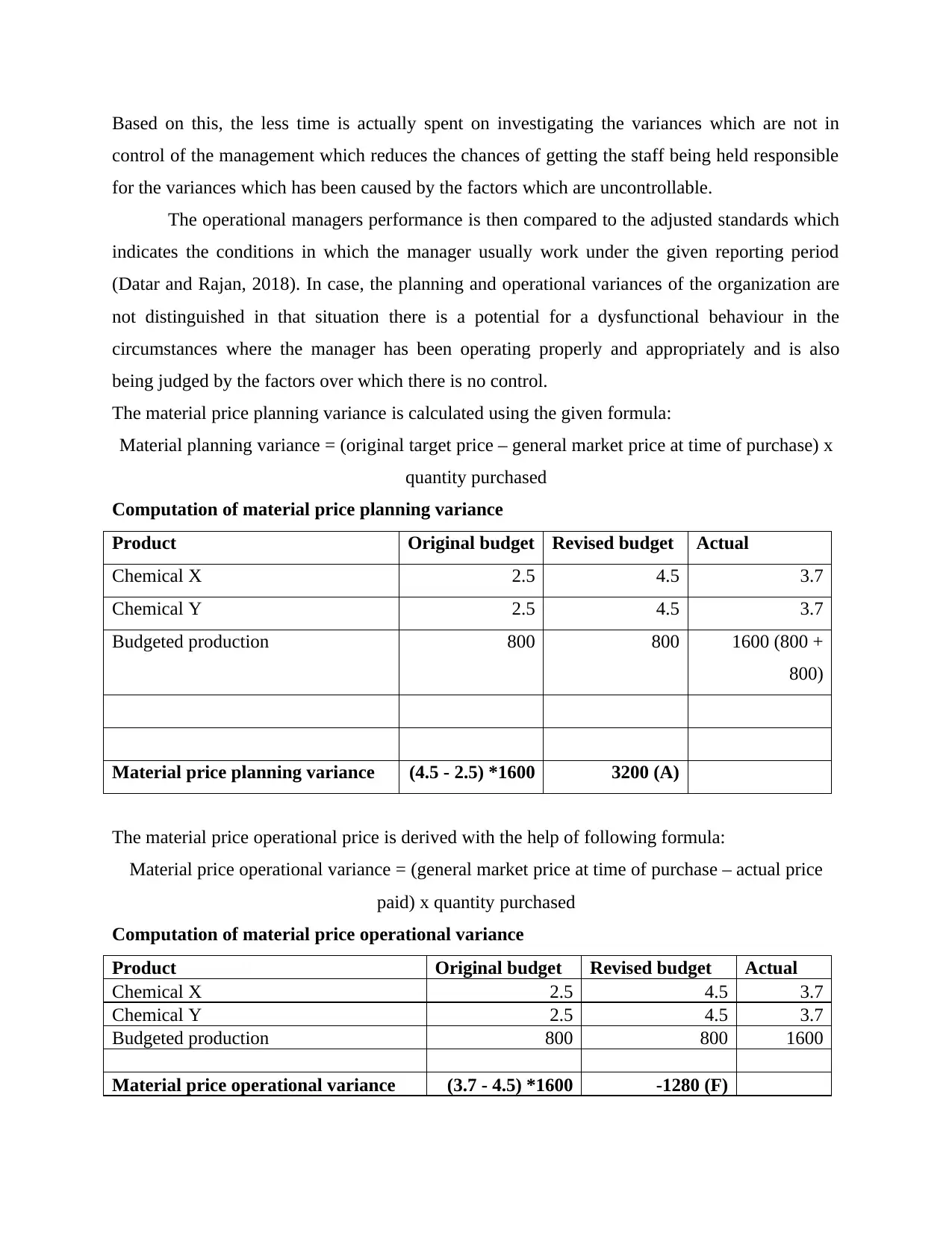
Based on this, the less time is actually spent on investigating the variances which are not in
control of the management which reduces the chances of getting the staff being held responsible
for the variances which has been caused by the factors which are uncontrollable.
The operational managers performance is then compared to the adjusted standards which
indicates the conditions in which the manager usually work under the given reporting period
(Datar and Rajan, 2018). In case, the planning and operational variances of the organization are
not distinguished in that situation there is a potential for a dysfunctional behaviour in the
circumstances where the manager has been operating properly and appropriately and is also
being judged by the factors over which there is no control.
The material price planning variance is calculated using the given formula:
Material planning variance = (original target price – general market price at time of purchase) x
quantity purchased
Computation of material price planning variance
Product Original budget Revised budget Actual
Chemical X 2.5 4.5 3.7
Chemical Y 2.5 4.5 3.7
Budgeted production 800 800 1600 (800 +
800)
Material price planning variance (4.5 - 2.5) *1600 3200 (A)
The material price operational price is derived with the help of following formula:
Material price operational variance = (general market price at time of purchase – actual price
paid) x quantity purchased
Computation of material price operational variance
Product Original budget Revised budget Actual
Chemical X 2.5 4.5 3.7
Chemical Y 2.5 4.5 3.7
Budgeted production 800 800 1600
Material price operational variance (3.7 - 4.5) *1600 -1280 (F)
control of the management which reduces the chances of getting the staff being held responsible
for the variances which has been caused by the factors which are uncontrollable.
The operational managers performance is then compared to the adjusted standards which
indicates the conditions in which the manager usually work under the given reporting period
(Datar and Rajan, 2018). In case, the planning and operational variances of the organization are
not distinguished in that situation there is a potential for a dysfunctional behaviour in the
circumstances where the manager has been operating properly and appropriately and is also
being judged by the factors over which there is no control.
The material price planning variance is calculated using the given formula:
Material planning variance = (original target price – general market price at time of purchase) x
quantity purchased
Computation of material price planning variance
Product Original budget Revised budget Actual
Chemical X 2.5 4.5 3.7
Chemical Y 2.5 4.5 3.7
Budgeted production 800 800 1600 (800 +
800)
Material price planning variance (4.5 - 2.5) *1600 3200 (A)
The material price operational price is derived with the help of following formula:
Material price operational variance = (general market price at time of purchase – actual price
paid) x quantity purchased
Computation of material price operational variance
Product Original budget Revised budget Actual
Chemical X 2.5 4.5 3.7
Chemical Y 2.5 4.5 3.7
Budgeted production 800 800 1600
Material price operational variance (3.7 - 4.5) *1600 -1280 (F)
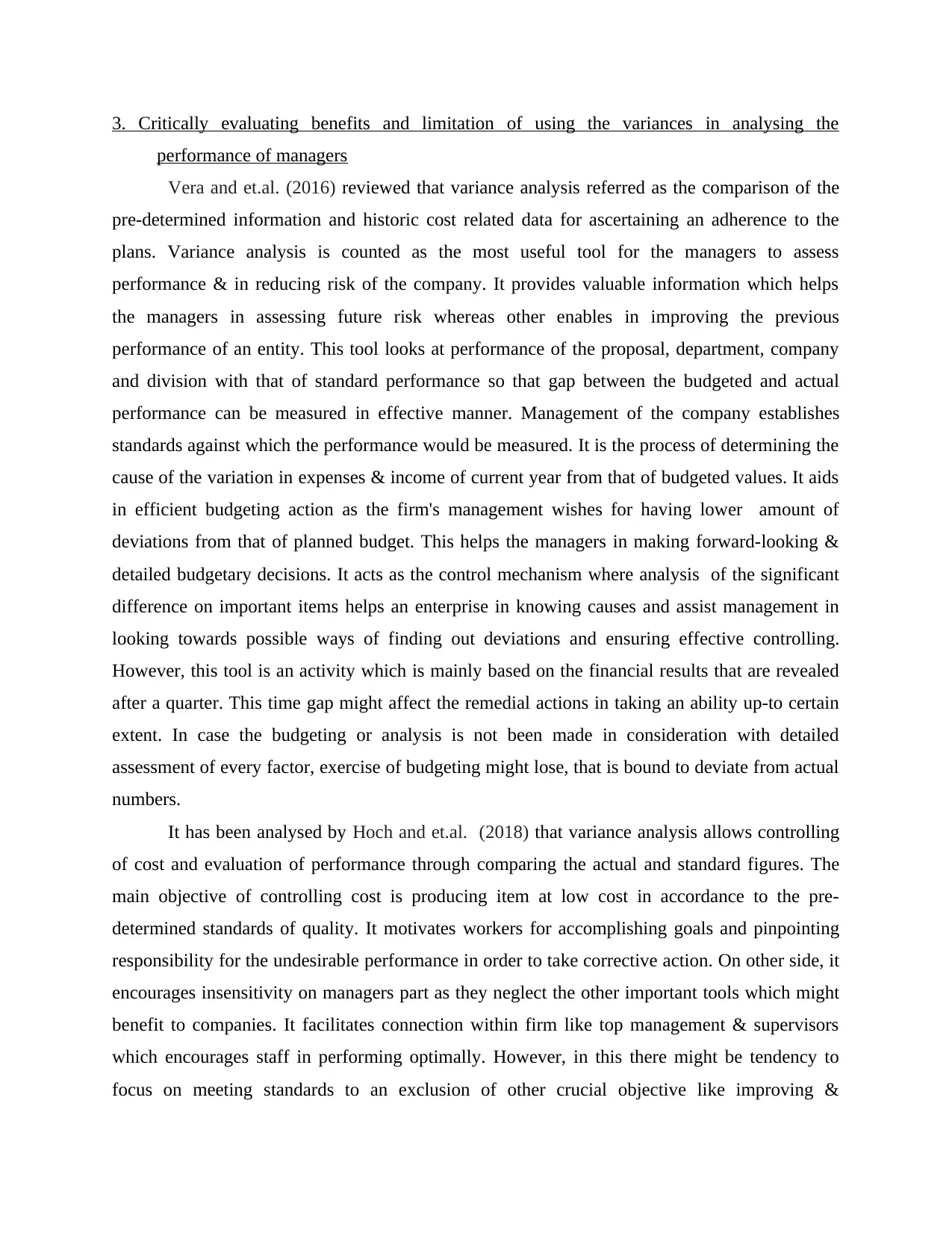
3. Critically evaluating benefits and limitation of using the variances in analysing the
performance of managers
Vera and et.al. (2016) reviewed that variance analysis referred as the comparison of the
pre-determined information and historic cost related data for ascertaining an adherence to the
plans. Variance analysis is counted as the most useful tool for the managers to assess
performance & in reducing risk of the company. It provides valuable information which helps
the managers in assessing future risk whereas other enables in improving the previous
performance of an entity. This tool looks at performance of the proposal, department, company
and division with that of standard performance so that gap between the budgeted and actual
performance can be measured in effective manner. Management of the company establishes
standards against which the performance would be measured. It is the process of determining the
cause of the variation in expenses & income of current year from that of budgeted values. It aids
in efficient budgeting action as the firm's management wishes for having lower amount of
deviations from that of planned budget. This helps the managers in making forward-looking &
detailed budgetary decisions. It acts as the control mechanism where analysis of the significant
difference on important items helps an enterprise in knowing causes and assist management in
looking towards possible ways of finding out deviations and ensuring effective controlling.
However, this tool is an activity which is mainly based on the financial results that are revealed
after a quarter. This time gap might affect the remedial actions in taking an ability up-to certain
extent. In case the budgeting or analysis is not been made in consideration with detailed
assessment of every factor, exercise of budgeting might lose, that is bound to deviate from actual
numbers.
It has been analysed by Hoch and et.al. (2018) that variance analysis allows controlling
of cost and evaluation of performance through comparing the actual and standard figures. The
main objective of controlling cost is producing item at low cost in accordance to the pre-
determined standards of quality. It motivates workers for accomplishing goals and pinpointing
responsibility for the undesirable performance in order to take corrective action. On other side, it
encourages insensitivity on managers part as they neglect the other important tools which might
benefit to companies. It facilitates connection within firm like top management & supervisors
which encourages staff in performing optimally. However, in this there might be tendency to
focus on meeting standards to an exclusion of other crucial objective like improving &
performance of managers
Vera and et.al. (2016) reviewed that variance analysis referred as the comparison of the
pre-determined information and historic cost related data for ascertaining an adherence to the
plans. Variance analysis is counted as the most useful tool for the managers to assess
performance & in reducing risk of the company. It provides valuable information which helps
the managers in assessing future risk whereas other enables in improving the previous
performance of an entity. This tool looks at performance of the proposal, department, company
and division with that of standard performance so that gap between the budgeted and actual
performance can be measured in effective manner. Management of the company establishes
standards against which the performance would be measured. It is the process of determining the
cause of the variation in expenses & income of current year from that of budgeted values. It aids
in efficient budgeting action as the firm's management wishes for having lower amount of
deviations from that of planned budget. This helps the managers in making forward-looking &
detailed budgetary decisions. It acts as the control mechanism where analysis of the significant
difference on important items helps an enterprise in knowing causes and assist management in
looking towards possible ways of finding out deviations and ensuring effective controlling.
However, this tool is an activity which is mainly based on the financial results that are revealed
after a quarter. This time gap might affect the remedial actions in taking an ability up-to certain
extent. In case the budgeting or analysis is not been made in consideration with detailed
assessment of every factor, exercise of budgeting might lose, that is bound to deviate from actual
numbers.
It has been analysed by Hoch and et.al. (2018) that variance analysis allows controlling
of cost and evaluation of performance through comparing the actual and standard figures. The
main objective of controlling cost is producing item at low cost in accordance to the pre-
determined standards of quality. It motivates workers for accomplishing goals and pinpointing
responsibility for the undesirable performance in order to take corrective action. On other side, it
encourages insensitivity on managers part as they neglect the other important tools which might
benefit to companies. It facilitates connection within firm like top management & supervisors
which encourages staff in performing optimally. However, in this there might be tendency to
focus on meeting standards to an exclusion of other crucial objective like improving &
Paraphrase This Document
Need a fresh take? Get an instant paraphrase of this document with our AI Paraphraser
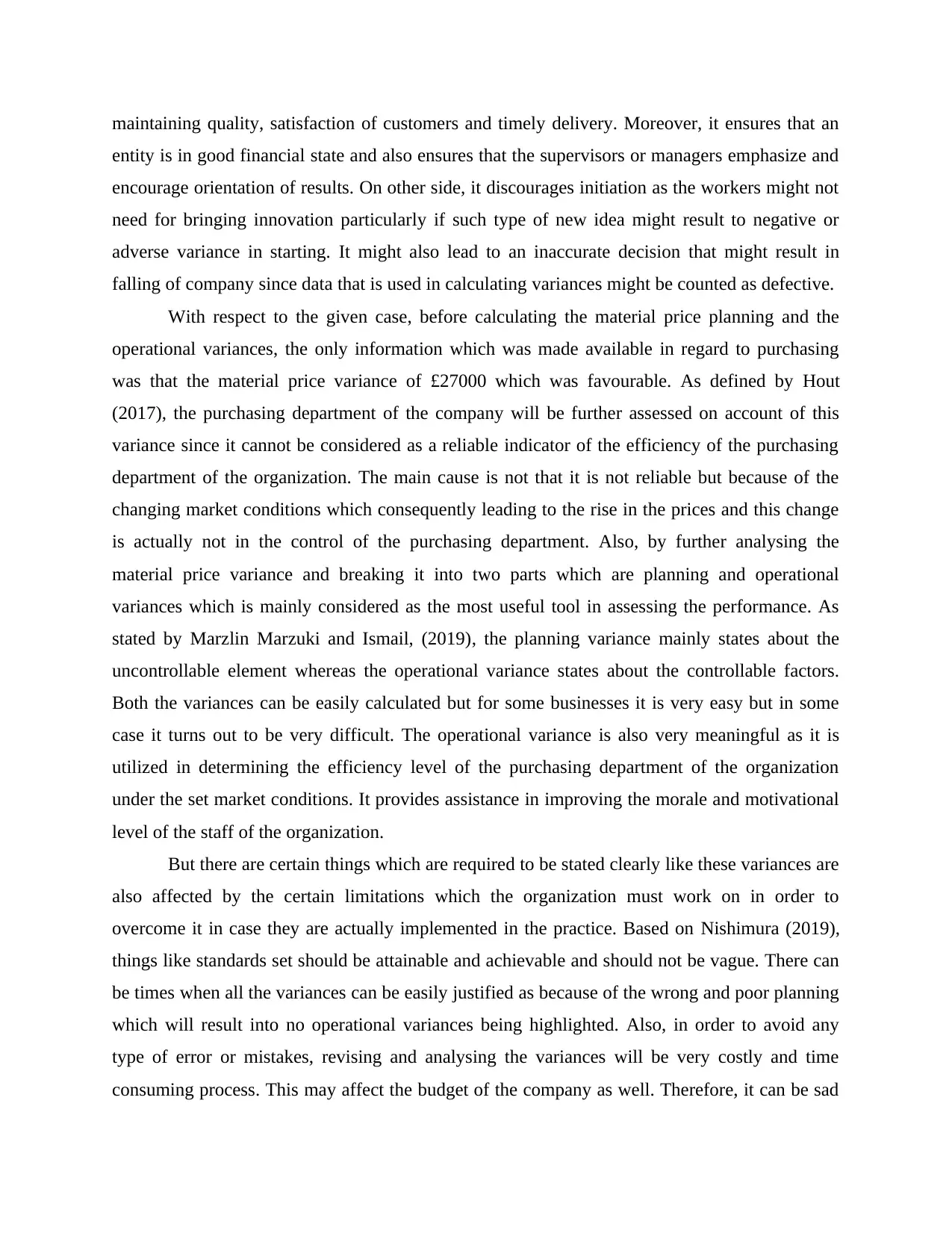
maintaining quality, satisfaction of customers and timely delivery. Moreover, it ensures that an
entity is in good financial state and also ensures that the supervisors or managers emphasize and
encourage orientation of results. On other side, it discourages initiation as the workers might not
need for bringing innovation particularly if such type of new idea might result to negative or
adverse variance in starting. It might also lead to an inaccurate decision that might result in
falling of company since data that is used in calculating variances might be counted as defective.
With respect to the given case, before calculating the material price planning and the
operational variances, the only information which was made available in regard to purchasing
was that the material price variance of £27000 which was favourable. As defined by Hout
(2017), the purchasing department of the company will be further assessed on account of this
variance since it cannot be considered as a reliable indicator of the efficiency of the purchasing
department of the organization. The main cause is not that it is not reliable but because of the
changing market conditions which consequently leading to the rise in the prices and this change
is actually not in the control of the purchasing department. Also, by further analysing the
material price variance and breaking it into two parts which are planning and operational
variances which is mainly considered as the most useful tool in assessing the performance. As
stated by Marzlin Marzuki and Ismail, (2019), the planning variance mainly states about the
uncontrollable element whereas the operational variance states about the controllable factors.
Both the variances can be easily calculated but for some businesses it is very easy but in some
case it turns out to be very difficult. The operational variance is also very meaningful as it is
utilized in determining the efficiency level of the purchasing department of the organization
under the set market conditions. It provides assistance in improving the morale and motivational
level of the staff of the organization.
But there are certain things which are required to be stated clearly like these variances are
also affected by the certain limitations which the organization must work on in order to
overcome it in case they are actually implemented in the practice. Based on Nishimura (2019),
things like standards set should be attainable and achievable and should not be vague. There can
be times when all the variances can be easily justified as because of the wrong and poor planning
which will result into no operational variances being highlighted. Also, in order to avoid any
type of error or mistakes, revising and analysing the variances will be very costly and time
consuming process. This may affect the budget of the company as well. Therefore, it can be sad
entity is in good financial state and also ensures that the supervisors or managers emphasize and
encourage orientation of results. On other side, it discourages initiation as the workers might not
need for bringing innovation particularly if such type of new idea might result to negative or
adverse variance in starting. It might also lead to an inaccurate decision that might result in
falling of company since data that is used in calculating variances might be counted as defective.
With respect to the given case, before calculating the material price planning and the
operational variances, the only information which was made available in regard to purchasing
was that the material price variance of £27000 which was favourable. As defined by Hout
(2017), the purchasing department of the company will be further assessed on account of this
variance since it cannot be considered as a reliable indicator of the efficiency of the purchasing
department of the organization. The main cause is not that it is not reliable but because of the
changing market conditions which consequently leading to the rise in the prices and this change
is actually not in the control of the purchasing department. Also, by further analysing the
material price variance and breaking it into two parts which are planning and operational
variances which is mainly considered as the most useful tool in assessing the performance. As
stated by Marzlin Marzuki and Ismail, (2019), the planning variance mainly states about the
uncontrollable element whereas the operational variance states about the controllable factors.
Both the variances can be easily calculated but for some businesses it is very easy but in some
case it turns out to be very difficult. The operational variance is also very meaningful as it is
utilized in determining the efficiency level of the purchasing department of the organization
under the set market conditions. It provides assistance in improving the morale and motivational
level of the staff of the organization.
But there are certain things which are required to be stated clearly like these variances are
also affected by the certain limitations which the organization must work on in order to
overcome it in case they are actually implemented in the practice. Based on Nishimura (2019),
things like standards set should be attainable and achievable and should not be vague. There can
be times when all the variances can be easily justified as because of the wrong and poor planning
which will result into no operational variances being highlighted. Also, in order to avoid any
type of error or mistakes, revising and analysing the variances will be very costly and time
consuming process. This may affect the budget of the company as well. Therefore, it can be sad
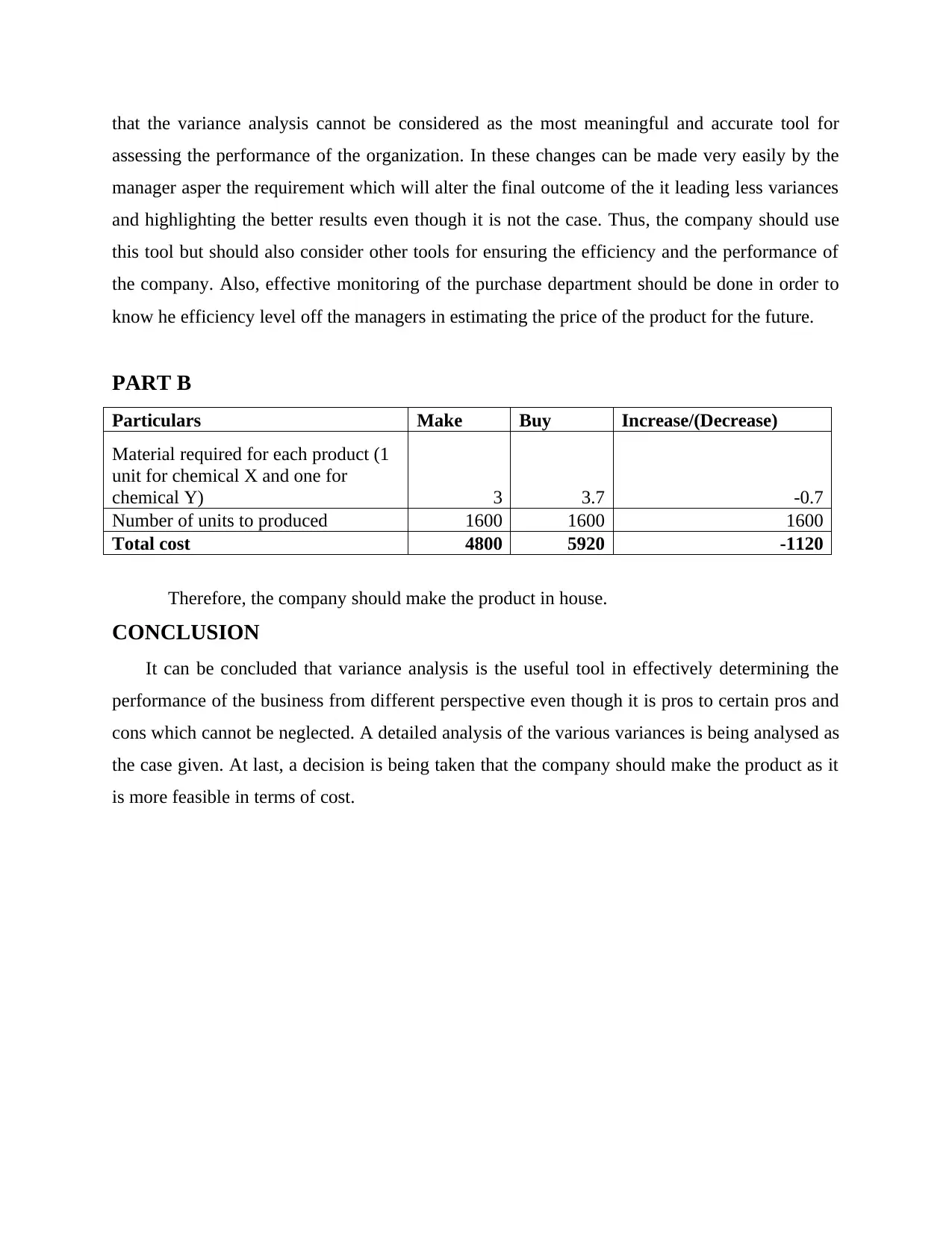
that the variance analysis cannot be considered as the most meaningful and accurate tool for
assessing the performance of the organization. In these changes can be made very easily by the
manager asper the requirement which will alter the final outcome of the it leading less variances
and highlighting the better results even though it is not the case. Thus, the company should use
this tool but should also consider other tools for ensuring the efficiency and the performance of
the company. Also, effective monitoring of the purchase department should be done in order to
know he efficiency level off the managers in estimating the price of the product for the future.
PART B
Particulars Make Buy Increase/(Decrease)
Material required for each product (1
unit for chemical X and one for
chemical Y) 3 3.7 -0.7
Number of units to produced 1600 1600 1600
Total cost 4800 5920 -1120
Therefore, the company should make the product in house.
CONCLUSION
It can be concluded that variance analysis is the useful tool in effectively determining the
performance of the business from different perspective even though it is pros to certain pros and
cons which cannot be neglected. A detailed analysis of the various variances is being analysed as
the case given. At last, a decision is being taken that the company should make the product as it
is more feasible in terms of cost.
assessing the performance of the organization. In these changes can be made very easily by the
manager asper the requirement which will alter the final outcome of the it leading less variances
and highlighting the better results even though it is not the case. Thus, the company should use
this tool but should also consider other tools for ensuring the efficiency and the performance of
the company. Also, effective monitoring of the purchase department should be done in order to
know he efficiency level off the managers in estimating the price of the product for the future.
PART B
Particulars Make Buy Increase/(Decrease)
Material required for each product (1
unit for chemical X and one for
chemical Y) 3 3.7 -0.7
Number of units to produced 1600 1600 1600
Total cost 4800 5920 -1120
Therefore, the company should make the product in house.
CONCLUSION
It can be concluded that variance analysis is the useful tool in effectively determining the
performance of the business from different perspective even though it is pros to certain pros and
cons which cannot be neglected. A detailed analysis of the various variances is being analysed as
the case given. At last, a decision is being taken that the company should make the product as it
is more feasible in terms of cost.
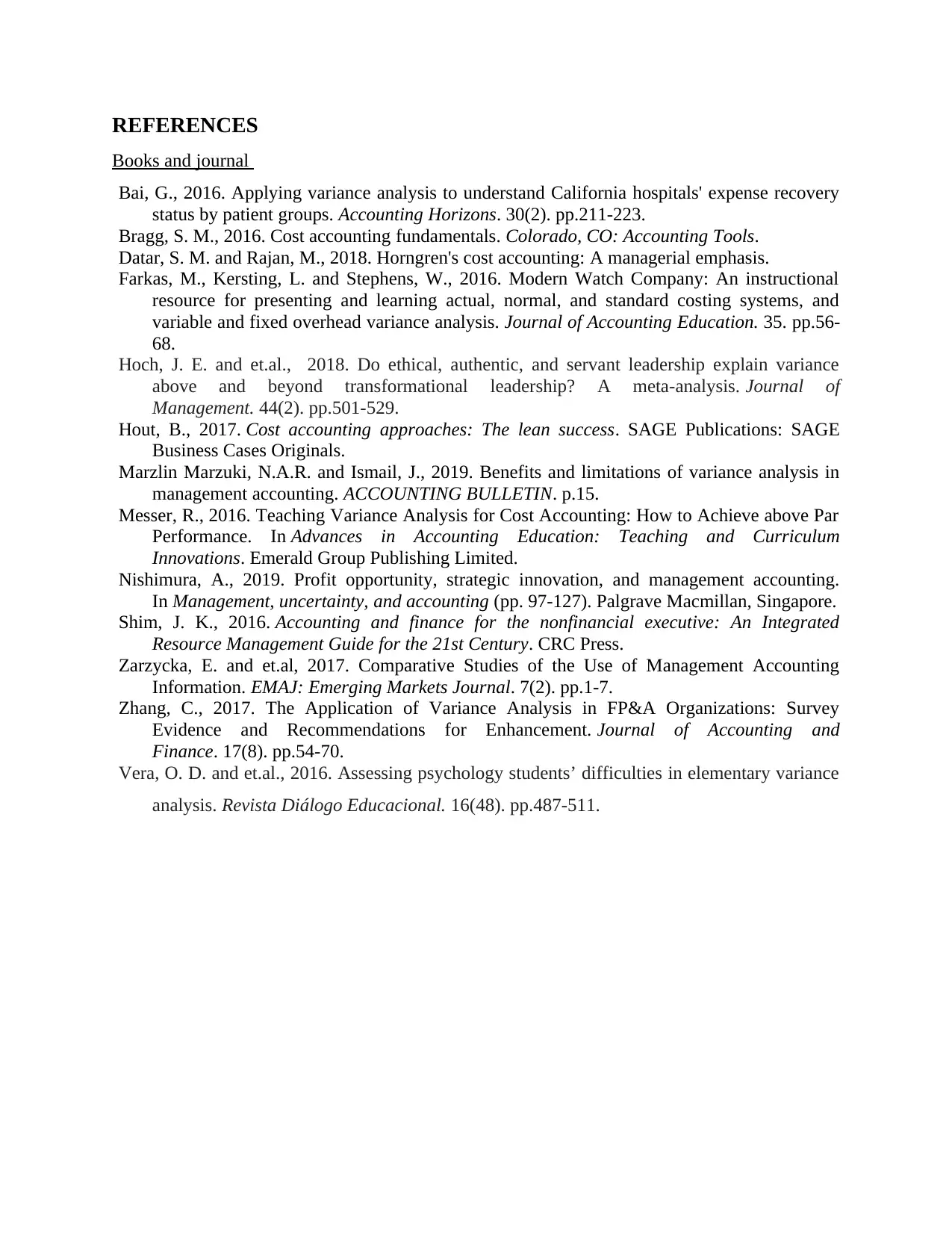
REFERENCES
Books and journal
Bai, G., 2016. Applying variance analysis to understand California hospitals' expense recovery
status by patient groups. Accounting Horizons. 30(2). pp.211-223.
Bragg, S. M., 2016. Cost accounting fundamentals. Colorado, CO: Accounting Tools.
Datar, S. M. and Rajan, M., 2018. Horngren's cost accounting: A managerial emphasis.
Farkas, M., Kersting, L. and Stephens, W., 2016. Modern Watch Company: An instructional
resource for presenting and learning actual, normal, and standard costing systems, and
variable and fixed overhead variance analysis. Journal of Accounting Education. 35. pp.56-
68.
Hoch, J. E. and et.al., 2018. Do ethical, authentic, and servant leadership explain variance
above and beyond transformational leadership? A meta-analysis. Journal of
Management. 44(2). pp.501-529.
Hout, B., 2017. Cost accounting approaches: The lean success. SAGE Publications: SAGE
Business Cases Originals.
Marzlin Marzuki, N.A.R. and Ismail, J., 2019. Benefits and limitations of variance analysis in
management accounting. ACCOUNTING BULLETIN. p.15.
Messer, R., 2016. Teaching Variance Analysis for Cost Accounting: How to Achieve above Par
Performance. In Advances in Accounting Education: Teaching and Curriculum
Innovations. Emerald Group Publishing Limited.
Nishimura, A., 2019. Profit opportunity, strategic innovation, and management accounting.
In Management, uncertainty, and accounting (pp. 97-127). Palgrave Macmillan, Singapore.
Shim, J. K., 2016. Accounting and finance for the nonfinancial executive: An Integrated
Resource Management Guide for the 21st Century. CRC Press.
Zarzycka, E. and et.al, 2017. Comparative Studies of the Use of Management Accounting
Information. EMAJ: Emerging Markets Journal. 7(2). pp.1-7.
Zhang, C., 2017. The Application of Variance Analysis in FP&A Organizations: Survey
Evidence and Recommendations for Enhancement. Journal of Accounting and
Finance. 17(8). pp.54-70.
Vera, O. D. and et.al., 2016. Assessing psychology students’ difficulties in elementary variance
analysis. Revista Diálogo Educacional. 16(48). pp.487-511.
Books and journal
Bai, G., 2016. Applying variance analysis to understand California hospitals' expense recovery
status by patient groups. Accounting Horizons. 30(2). pp.211-223.
Bragg, S. M., 2016. Cost accounting fundamentals. Colorado, CO: Accounting Tools.
Datar, S. M. and Rajan, M., 2018. Horngren's cost accounting: A managerial emphasis.
Farkas, M., Kersting, L. and Stephens, W., 2016. Modern Watch Company: An instructional
resource for presenting and learning actual, normal, and standard costing systems, and
variable and fixed overhead variance analysis. Journal of Accounting Education. 35. pp.56-
68.
Hoch, J. E. and et.al., 2018. Do ethical, authentic, and servant leadership explain variance
above and beyond transformational leadership? A meta-analysis. Journal of
Management. 44(2). pp.501-529.
Hout, B., 2017. Cost accounting approaches: The lean success. SAGE Publications: SAGE
Business Cases Originals.
Marzlin Marzuki, N.A.R. and Ismail, J., 2019. Benefits and limitations of variance analysis in
management accounting. ACCOUNTING BULLETIN. p.15.
Messer, R., 2016. Teaching Variance Analysis for Cost Accounting: How to Achieve above Par
Performance. In Advances in Accounting Education: Teaching and Curriculum
Innovations. Emerald Group Publishing Limited.
Nishimura, A., 2019. Profit opportunity, strategic innovation, and management accounting.
In Management, uncertainty, and accounting (pp. 97-127). Palgrave Macmillan, Singapore.
Shim, J. K., 2016. Accounting and finance for the nonfinancial executive: An Integrated
Resource Management Guide for the 21st Century. CRC Press.
Zarzycka, E. and et.al, 2017. Comparative Studies of the Use of Management Accounting
Information. EMAJ: Emerging Markets Journal. 7(2). pp.1-7.
Zhang, C., 2017. The Application of Variance Analysis in FP&A Organizations: Survey
Evidence and Recommendations for Enhancement. Journal of Accounting and
Finance. 17(8). pp.54-70.
Vera, O. D. and et.al., 2016. Assessing psychology students’ difficulties in elementary variance
analysis. Revista Diálogo Educacional. 16(48). pp.487-511.
1 out of 10
Related Documents
Your All-in-One AI-Powered Toolkit for Academic Success.
+13062052269
info@desklib.com
Available 24*7 on WhatsApp / Email
![[object Object]](/_next/static/media/star-bottom.7253800d.svg)
Unlock your academic potential
© 2024 | Zucol Services PVT LTD | All rights reserved.





